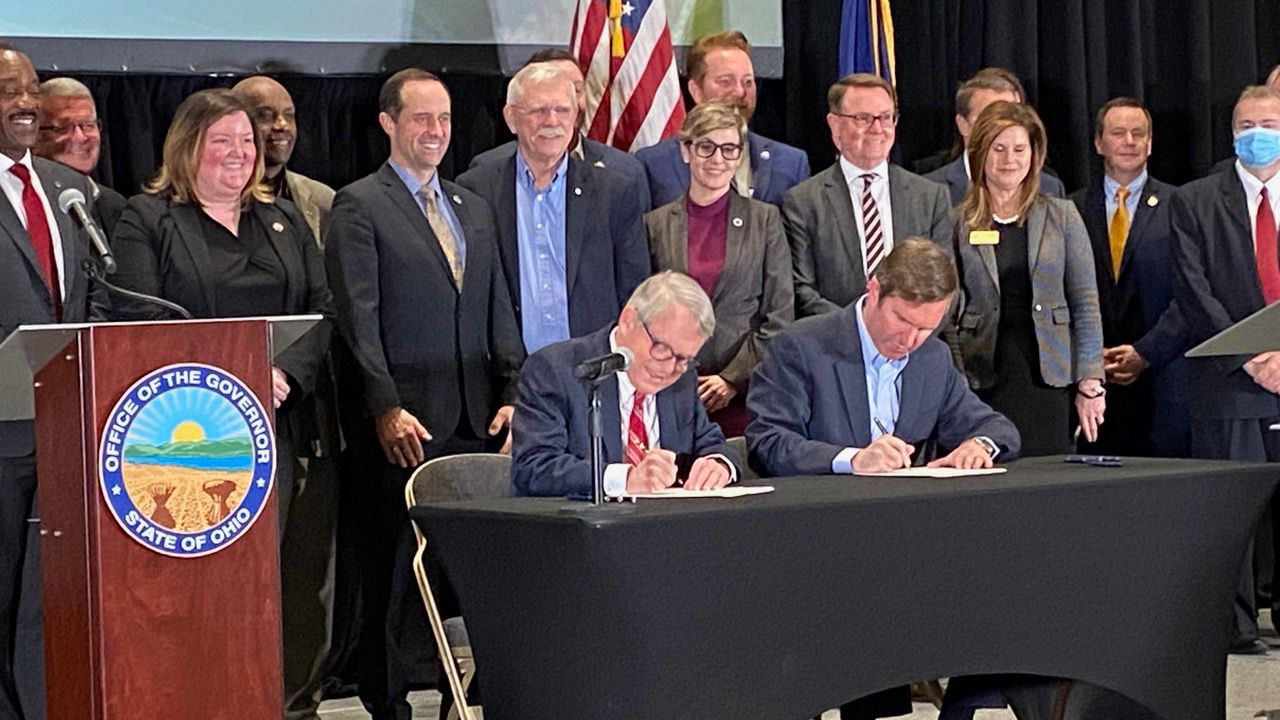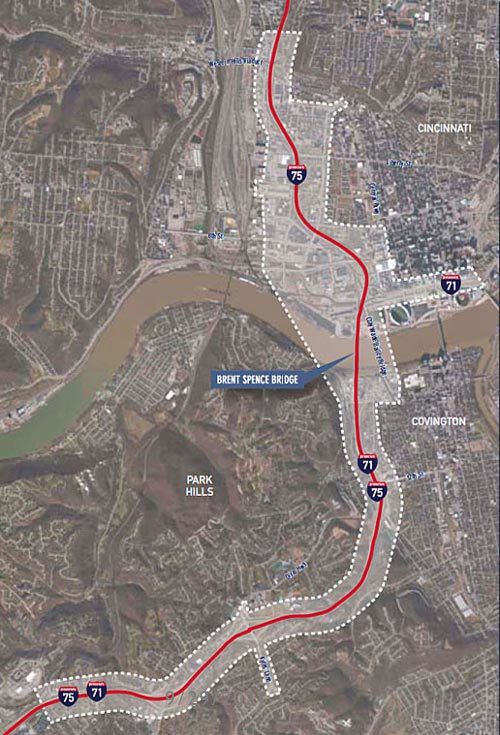COVINGTON, Ky. — The governors of Ohio and Kentucky have come together to pursue up to $2 billion in federal funding to get the long-planned and much-anticipated Brent Spence Bridge project underway.
What You Need To Know
- The governors of Kentucky and Ohio have signed an MOU related to the proposed Brent Spence Bridge project
- The deal aims to align the two states in the eyes of Washington, D.C., leaders
- The $2.8 billion project will require $2 billion from the federal government to move forward
- Both state leaders say there are no plans to add tolls
Ohio Gov. Mike DeWine and Kentucky Gov. Andy Beshear were in Covington, Kentucky on Monday to sign a memorandum of understanding (MOU) outlining the joint efforts the two states will take to secure the necessary funds from the $1.2 Bipartisan Infrastructure Law to pay for the project.
The announcement included Ohio and Kentucky’s intention to construct the project–which includes the building of a new companion bridge alongside the Brent Spence Bridge–without the use of tolls.

The MOU outlines the states’ obligations regarding the project. It’s hoped the document will also spell out to leaders in Washington, D.C., that Ohio and Kentucky are aligned on the project and ready to work together.
“We’re ready,” Beshear said during a media event at the Northern Kentucky Convention Center in Covington, located about 3/4 of a mile from the Brent Spence Bridge.
“With today’s signing, the Commonwealth of Kentucky and the State of Ohio are aligning our efforts to make this project a reality,” he said. “This project shows what we in government can do when we embrace cooperation and progress and simply do what is best for our people.”
DeWine said the Brent Spence Bridge has been a problem for years. Constructed in the 1963 to carry around 80,000 vehicles a day, the bridge's daily Interstate 75 and Interstate 71 traffic load has reached double that, 160,000 vehicles.
The bridge, which spans the Ohio River between Covington and Cincinnati, is the linchpin to the I-75 trade corridor between Michigan and Florida. It was once the busiest trucking route in the United States.
Today, it’s also among the most congested.
For the second year in a row, the American Transportation Research Institute declared the I-71 and I-75 confluence at the Brent Spence Bridge the second-worst in the entire country.
In addition to causing gridlock, and possible headaches for motorists, the increased vehicle congestion also leads to more traffic collisions, according to the Ohio-Kentucky-Indiana Regional Council of Governments. OKI has final authority over all federal dollars spent on surface transportation in the region.
If awarded, the Brent Spence Bridge project would not replace the existing bridge, which is structurally sound, according to transportation officials in both states. Instead, the bulk of the estimated $2.8 billion project would go toward constructing a companion bridge – or span – just to the west of the Brent Spence Bridge to give drivers an alternative route across the river.
The project would also make repairs to the existing bridge and perform road work to improve gridlock throughout the eight-mile interstate network corridor.
"For decades, the backups on the Brent Spence Bridge have frustrated drivers, hindered economic development, and slowed supply chain deliveries. Today, a solution is in reach, and we are committed to aggressively working together to secure this funding to help us fix this transportation nightmare once and for all," DeWine said.
The governor feels going through with the bridge plan would keep this “major transportation network open and moving will also have a significant positive impact on our national economy and national security.” DeWine thinks it would improve the quality of life for the local residents who rely on it every day as well.
While most regional leaders have long sought a solution for the Brent Spence Bridge problems, leaders in Covington have tempered that optimism in recent years. While they’ve wanted a solution to traffic problems, they feared the situation as planned could be harmful to some riverfront cities and neighborhoods. Concerns ranged to the size of the span to economic impacts for small businesses.

Covington Mayor Joe Meyer, who was in attendance Monday, said he felt reassured that Beshear, DeWine and the project team seemed open to continued engagement on the process.
Beshear specfically addressed Covington in his remarks, saying “We will continue to look for opportunities to reduce costs and the footprint of the project and to engage our communities. Mayor Meyer, I wanted to say that punctually – to engage our local communities.”
Overall, Meyer is “thrilled” with the announcement, calling it an overall “huge win” for the region, especially since officials are saying they won’t need to include tolls.
“We’ve been in ongoing discussion with Gov. Beshear and the Kentucky Transportation Cabinet (KYTC) on these issues, so we believe the governors are sincere. Again, this was a good day,” Meyer said.
Involved parties are still awaiting clear direction on federal guidelines and regulations on how to access necessary federal funding. That includes both the formal process and timeline for any grant proposals.
“The signing of this document is a very clear and public show of action by both states,” said Dr. Jack Marchbanks, director of the Ohio Department of Transportation, called Monday a “critical step” to make sure the project is competitive in the federal grant review process.
If the project receives the requested federal funds, the governors said they believe both states have or could come up with the rest of the money needed for the project. They did not release specifics on how that would break down.
Beshear feels that being aligned on the process and having a mostly complete plan in place positions the states to “quickly apply for these federal dollars, which will allow us not only to build this new bridge.”
One thing that was stated multiple times was that the project does not include tolls.
The memorandum also directs ODOT and KYTC to begin preparations for construction. Those teams have been planning this project for nearly two decades. Most of the critical groundwork is complete so the project is nearly shovel ready, Marchbanks said.
Because of years of previous planning, transportation officials said they expect project construction could begin in 2024 if funding is received. But Beshear said that even it might seem like an ambitious goal, he wants to break ground next year.
ODOT said a conservative construction timeline for the project is five years.
“This project shows what we in government can do when we embrace cooperation and progress and simply do what is best for our people,” Beshear said.
David Painter, the president of OKI and a Clermont County commissioner, said every citizen in the region should applaud DeWine and Beshear for their “difficult achievement” in taking the Brent Spence Bridge project forward.
“I am more optimistic than ever that the region will finally see the completion of this desperately needed project,” he said.



